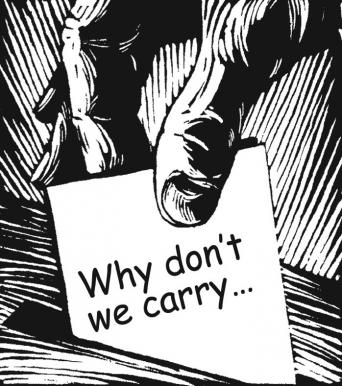
Suggestion Box: Watch Your Waste
Greetings and thanks for writing. As usual, suggestions and responses may have been edited for brevity, clarity, and/or comedy. In addition, no idea, concept, issue, remark, phrase, description of event, word, or word string should be taken seriously. This also applies to the previous sentence.
As I’m writing this, Weavers Way staff is busy stickering the 967 turkeys our shoppers ordered for Thanksgiving, probably totaling about 17,000 pounds. Assuming 40% of a whole bird is edible, that’s about 6,800 pounds of turkey meat being eaten by Weavers Way households this week. I found online that the average American eats about 2,000 pounds of food per year, or about 5.5 pounds a day. This seems like a lot of food moving through the food system and, ultimately, our bodies and the waste stream. With the turkeys, Weavers Way shoppers are sending about 10,200 pounds of inedible turkey bone and skin into the waste stream before even one bite is eaten and even one calorie or gram of protein and other nutrients is added to the eater’s own internal supply.
Naturally, most foods result in some waste — even the most sustainably grown and nutrient-dense products: apple cores, banana peels, bean and seed pods, etc. It’s interesting to note that it seems vegetables have less waste. (You don’t have to peel romaine lettuce, kale, or tomatoes and such.) Plus, plenty of veggies can be eaten with the peel on; in fact, in many cases, peels pack a lot of nutrients and fiber.
Of course, you kind of have to “peel” a turkey (or any meat) to eat it, resulting in, for most of us, trash. Turkey bones are theoretically compostable, but because they require anaerobic bacteria to break down the protein — which can result in smells, bugs, and attracting rodents and other animals — you have to be set up to do it with specialized containers that both prevent animals yet supply enough ventilation for the breakdown to happen. For most households, this means bones and skin are going in the trash.
With genetic engineering progressing apace, and given our interest in minimizing waste, scientists are working on genetically engineering turkeys to have skin and bones that are made from recyclable plastic, hopefully #1 coded, so all that will be needed in the future is a quick rinse to get the fat off, and into the blue bucket it will go. Incidentally, if you’ve ever wondered what happens to all the feathers from the poultry industry, many are rendered and ground up to become animal feed for ruminants and, surprisingly, an ingredient in fertilizer for organic gardens.
suggestions and responses:
s: “Can bread be split to buy half loaves?”
r: (Jenna MA) Yes, bread can be split in half loaves. You can always preorder a half loaf so it’s ready for pick-up on your preferred day.
s: “Can people please be mindful to place their baskets on the counter provided?”
r: (Norman) People mindful? This is Philadelphia, not Denver. Look at all the trash on the sidewalks.
s: “Can you ask Roling’s to send more small challahs? There are lots of whole wheat that don’t seem to go by 5 p.m. Friday. Perhaps less whole wheat, more small raisin.”
r: (Jenna MA) Yes! I will adjust my order to reflect these changes. Thanks for your suggestion!
s: “Oatly’s whipped cream. Had it in Sweden and it’s delicious.”
r: (Norman) We’ll send one of our trucks on a foraging mission to Sweden. We’ll need a few handy cooperators to build a ferry — sign up on the work calendar. We can use some of the wood left from our Ambler store construction.
s: “Can we get Obi probiotic, organic root beer soda?”
r: (Norman) Haven’t seen a supplier that serves our area yet.
s: “Cauliflower crusted pizza”
r: (Norman) So much of society has changed recently and is continuing to change every day. Many traditionalists have contacted us pleading for Weavers Way to honor classic traditions and eschew things such as vegan cheese, oat whipped cream, and cauliflower pizza crust. By definition, pizza crust can only be made with leavened dough. Cauliflower is not an ingredient in dough, and you can’t leaven cauliflower, at least not in this country, not without an Act of Congress or Executive Order. There are some things that, even as politically divided as we are today, we can all agree on, or at least have a supermajority on, dough ingredients not including cauliflower is one of them. However, like any dissident in a free country or co-op, you are free to express your opinion utilizing public speech, a free press, and hiring lobbyists.
s: “We keep running out of soft pretzels on Saturday, real bummer.”
r: (Norman) Speaking of dough and traditional foods, soft pretzels are a Philadelphia icon of what started out as a recipe traded by a hobo for a meal. We’ll try not to run out, and if we do, we’ll have an acceptable substitute, like cauliflower soft pretzels.
s: “Amaranth Brownie taste like Play-Doh.”
r: (Norman) FYI, Play-Doh is not real dough, though it does contain wheat and salt like many edible doughs. Although non-toxic, it is not food and should not be eaten. Not sure why you ate it. Amaranth Brownies, although apparently not a pleasing flavor for you, would nevertheless be a healthier choice. FYI, Amaranth Bakery is a gluten-free bakery in Lancaster, PA. Oddly, none of their products contain Amaranth, a pseudocereal once prized by the Aztecs, who neither knew nor cared about it being a gluten-free food.
